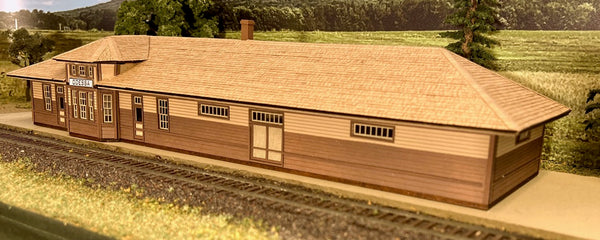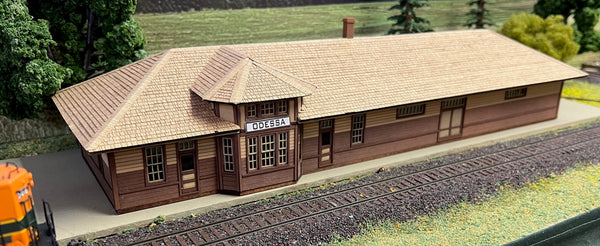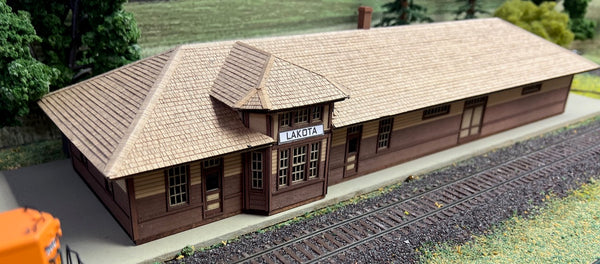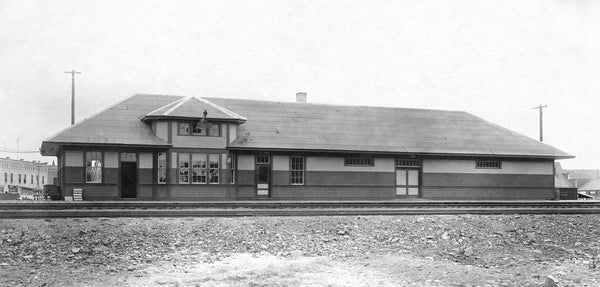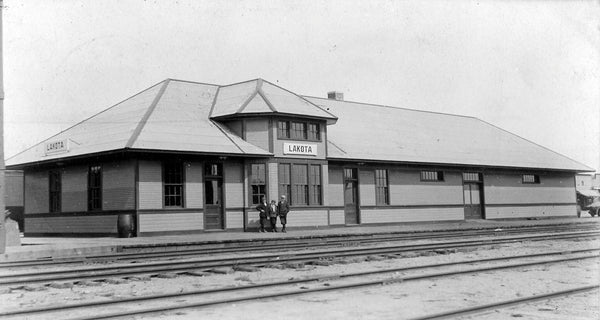30x112 1-1/2 story bay window Left Handed Combination Depot, Plan 7619 - HO
The Great Northern Railway Historical Society Company Store is pleased to offer this HO scale kit of the 30’ x 112’ one and one half story bay window, left handed Standard Plan 7619 combination passenger and freight depot. Using blueprints from our archives, the kit is custom made for you by Hidden River Manufacturing.
Depot featuring the one half story bay window design element were placed at: Odessa WA in 1909, Lakota ND in 1910, Monroe WA in 1910, Warren MN in 1911, Marcus WA in 1913, Pateros WA in 1913, Chelan WA in 1914, and Sandstone MN in 1922. The Marcus depot was to replace a previous structure lost to fire. It was only 90 feet long and was relocated in 1941 to Kettle Falls to escape the impending flooding of Marcus by Lake Roosevelt behind Grand Coulee Dam.
Odessa and Monroe are main line stations in Eastern and Western Washington respectively. Lakota is west of Grand Forks on the main line to Devil's Lake. Marcus was about 100 miles north of Hillyard and was where the Republic branch separated from the line to Nelson, BC. Pateros and Chelan are stations on the Wenatchee-Oroville branch which was placed in service in 1914.
Warren, Minnesota is located 30 miles north of Crookston, Minnesota on the main line to Winnipeg. Sandstone, Minnesota is located 97 miles north of St. Paul, on the main line to Superior and Duluth. The town was built to support a large sandstone quarry nearby. The depot was completed in February 1922, and was the last depot built in the 1-½ story bay window configuration.
Odessa, Lakota, Warren, Monroe, and Chelan were left handed structures.
The model features two cupola roof designs, one for Lakota ND, and one for all the others.
All but one of these depots were built with roofs using 'prepared roofing' which was prepared by saturating felt with asphalt. In service, when the oil evaporated out of the asphalt, the felt became dry and brittle ending the life of the covering. This material proved to be deficient at shedding water, and was replaced by shingles. GN revised their architectural drawing in December 1915, to change the roofing material from prepared roofing to cedar shingles. Starting in the 1920s, multiple AFEs were approved for the replacement of prepared roofing on buildings, typically with cedar shingles. The model is done with a shingle roof. If you want to have the roof appear as it was initially constructed, you can easily reproduce the look of prepared roofing using an appropriate weight of construction paper.
This kit features: exterior and interior walls, flooring, removable roof with soffit, and interior details that are 100 percent laser-cut from quality basswood and aircraft grade 3-ply birch plywood with custom laser-scribed siding and eave; laser cut decorative random width cedar roofing shingle strips; the depot design’s hallmark one and one half story bay window with two bay front windows; laser-cut peel & stick doors; windows with glazing and trim – all that assemble with ease; injection molded chimney; and clear concise illustrated instructions. The two restroom windows have frosted glazing, as did the original depots
This HO model assembled is 16-1/2” long and 5” wide roof dimensions. Nine sets of station sign boards are included, one for each Great Northern stations using this style depot. Platforms are not included.
Depot platforms at Lakota were 16' wide at the front, 12' wide at both ends and 8' wide at the rear. The rear platform connected to an 8" x 200' transfer platform. The transfer platform was probably there because Lakota was the main line end of a branch, and LCL traffic was transferred at Lakota between main line and branch line cars.
A Reference Sheet titled Great Northern's Passenger Depot at Lakota North Dakota, Part 1, now under development will provide historical information about this depot design and facilities at Lakota.
The color photo of the manufacturer’s prototype is not painted in any known Great Northern Railway depot paint scheme. The red color is incorrect and the areas it is applied on are generally incorrect.
The first depot of this style was constructed at Odessa WA in 1909.
Starting in 1909, the standard paint scheme for new frame depots was medium yellow-buff on large wall sections with a darker olive-green trim on windows and doors, belt rails and corner posts.
Several photos of the Odessa Depot taken just before it was opened show an experimental paint scheme that the GN tried before settling on a permanent standard. The walls and ends of Odessa are painted with a dark color up to six feet, with a lighter color, presumably yellow-buff, above that. The trim color is even darker than the dark body color. Depots at Crosby and Dunseith, ND were painted in another proposed scheme circa 1908-09, which was the reverse of the standard scheme later adopted. The Crosby and Dunseith experimental scheme had the dark olive-green on all wall sections with yellow-buff trim on windows and doors, belt rails and corner posts.
GNRHS member Andrew Klamka is now developing a Reference Sheet on the history of the Lakota ND depot, which was built in 1910 to this plan. The photos of the Lakota depot in that Reference Sheet will show the correct color pattern as does one of the thumbnail photos in this store item. There is an exchange of letters dated July 1910 in the Lakota AFE file about the contractor using a darker than specified color on the body. This indicates confusion or misunderstood instructions somewhere. Real history is often messy.
DEPOT COLORS
The Great Northern Railway changed its paint scheme for wooden buildings, including depots, from time to time. This makes the color of frame buildings a clue to the time frame you are modeling.
Starting in 1909 new frame depots were painted medium yellow-buff on large wall sections with a darker olive-green trim on windows and doors, belt rails and corner posts. In September of 1930, the two-tone gray scheme of light gray on the main structure and darker gray trim on windows, doors, belt rails and corner posts was introduced. Existing depots were repainted as required. The gray was followed after 1950 by white as the main color with green trim on windows, doors, belt rails and corner posts. Photos taken in the middle and late 1960s show many depots painted all white with green trim only on windows. A few of the two-tone gray depots were never repainted until after the BN merger. Station name boards were always white with black lettering and black trim along the edges.
See RS 35, RS 53, 154, RS 397, and RS 402.
Explanatory notes:
Note 1: The change to yellow-buff with olive green trim was made official with the new 1909 depot style featuring belt rails, boxed eaves, angled bay, and different siding widths above and below the belt.
Note 2: In Reference Sheet 402 the term “yellow-buff” was used, rather than the yellow-ochre of RS 53 which called the depot trim a “darker ochre.” That term is very confusing and not at all descriptive of a color with a definite green cast. There was some confusion among GNRHS members about these colors when these ochre descriptions were written in the 1970s.
Note 3: Actual boards collected from several depots now exist in the Jackson Street Roundhouse (JSRH) Archives in St. Paul. These boards have colors consistent with the colors as described here. The colors stated here are also confirmed in documents and corporate files located at JSRH and Minnesota History Museum. Martin Evoy’s extensive files preserved at JSRH have also been carefully examined, as well as paint chips collected by Martin and others.






